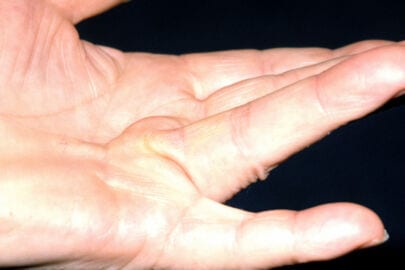Patients often seek care from or are referred to a hand surgeon when the signs of Dupuytren’s disease arise. A visit with the hand surgeon can help confirm the diagnosis, further educate the patient, and devise a care plan.
Treatment indications
Patients invariably ask whether they need treatment for their Dupuytren’s disease. If Dupuytren’s does not cause any contracture, the best course of action is to monitor the condition over time. Some nodules and cords may disappear with time or remain stable, whereas others may contract fingers over time.
Traditionally, treatment is reserved for those who have developed contractures of the joints of the fingers. A good way to assess for the presence of a contracture is the tabletop test. If the hand cannot be laid flat on a table, a significant contracture is likely present. Typically, a 30 degree contracture of the MCP joint or any degree contracture of the PIP joint should be treated.
Available treatments
- Surgery
- Needle aponeurotomy
- Collagenase injection
While these treatments can allow the fingers to straighten once again, they are not cures for Dupuytren’s disease. Dupuytren’s disease has no known cure or proven prevention. No medication or surgery exists that eliminates the underlying biology. The consequence of this is that signs of Dupuytren’s disease, including contractures can recur after treatment.
Each of these is further discussed below.
Surgery
Surgery is the most common treatment for Dupuytren’s contracture. Under anesthesia and in the operating room, the surgeon approaches the cords via incisions on the hand and fingers. The diseased elements can then be cut or removed, potentially allowing the fingers to straighten. If a joint remains stiff following cord removal, it can be further treated with additional joint releases. The wounds may be closed, left open to heal on their own, or covered with a skin graft.
n certain cases, a different approach may be employed: pins inserted into the bones of the finger allow forces to be applied that will gradually straighten the finger over time, removing the contracture.
Collagenase
Collagenase, known by its trade name Xiaflex, is a drug that dissolves collagen, the building blocks of a Dupuytren’s cord. When a Dupuytren’s cord is treated with collagenase, the collagenase is injected into the cord. This causes the cord to weaken as the collagenase breaks down the collagen. After a period of one to several days, the physician then “manipulates,” the finger in to extension, rupturing the cord and allowing the finger to straighten. A collagenase injection is typically performed in the office setting, and requires no sedation or general anesthesia.
Needle aponeurotomy
Needle aponeurotomy is a procedure where a hypodermic needle is inserted through the skin of a numbed-up finger or palm. The bevel of the needle is used to carefully cut through the cord in multiple locations. This weakens or severs the cord, allowing the physician to straighten the digit. Needle aponeurotomy is also typically performed in the office setting.
One additional treatment scenario is worth mentioning. Sometimes Dupuytren’s disease can cause large or painful nodules to form in the palm, without necessarily causing any contracture of a finger. In this case, steroid injections may shrink the nodule and decrease pain associated with it.
Which procedure is best?
No single procedure is uniformly superior to the others. Because each presentation of Dupuytren’s is unique, and because each patient is different, an individualized approach is recommended. Multiple factors may determine the optimal treatment: the severity of the disease, a patient’s previous treatments, the physician’s experience, the patient’s own preferences, and costs associated with each procedure.
It is worthwhile for the patient to discuss all available treatment options with the physician before settling on an optimal treatment plan.
After treatment
After the procedure, a period of splinting the digits into extension, often at night, is recommended to avoid redevelopment of contracture. A referral to a hand therapist is usually made to improve hand function, swelling, pain, and scarring. The length of recovery may depend on the severity of the condition and extent of the procedure performed.
Recurrence of Dupuytren’s
Dupuytren’s disease has no cure or prevention. While these treatments allow the fingers to straighten, they do not eliminate the underlying condition and its tendency to form contractures. Recurrences are common in the first few years after interventions, and can exceed a rate of 50% at 5 years. Fortunately, when contractures redevelop, they can again be treated by the options described above.
For more information, book an appointment.




